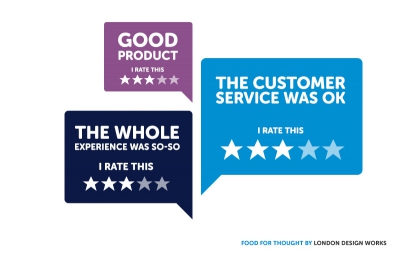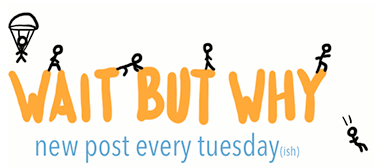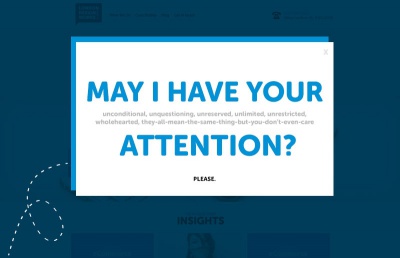0207 490 2311
Phone for sales and support

Jamie Harper
Spend days duking it out with synonyms, sometimes for global brands.
Want persuasive copy? Stop thinking about yourself.

Question: People come to your website to read about your business, right?
Wrong.
They come to find the answer to a problem.
Almost without exception your visitors will be looking for signs that you understand their problems and have the knowledge, services or products to solve them. Flapping your gums about how you “pride yourselves” on your service isn’t going to cut it.
Here are some tips on how to hand your audience a piping hot serving of what-they-want-to-hear.
Identify your audience’s problem
Great copy comes from knowing as much as possible about your product and - most importantly - about your reader. So your first job is detective work. Think about why your reader is researching your business. What problem do they need to solve? What are their fears and desires? Find the answers and you have a framework for your content.
Dramatise the problem: Show that you know
Identifying with what your reader is thinking and feeling will put you streets ahead of countless businesses when it comes to writing copy. But it’s just the start. You have to show your reader that you understand their needs, desires and doubts and can empathise with their situation.
Let’s say you sell running trainers online. Which of the following is more persuasive?
“These trainers are simply the best for off-road running.”
“When you are hurtling down a muddy trail at full tilt, you need a shoe that gives you grip as well as speed. This is that shoe.”
You have to show your understanding of your reader’s world; that you are looking at their problem from their viewpoint. Embrace vivid language. Be specific. Spike your copy with realism. Your reader will come along for the ride.
Show how you can solve the problem
Okay, by now you know what your reader is looking for. And you have dramatised it in your copy. Nice. The final step is to show how you can solve the problem. What is it about your product that makes it the best answer? How will your service win the day for your reader? Compelling answers will make your business irresistible.
It’s not enough to say “this product is perfect for x” or “our service will help you with y”. That might have worked in the 1980s. But today it’s about zeroing in on the benefits of what you do and what you sell; explaining how and why your business solves your reader’s problems. Don’t leave your reader to put the story together. They won’t.
Wrap it up in a good story...
Like it or not, your brain is hard-wired to react to stories. Before the evolution of writing, the verbal recycling of information was crucial to the survival of mankind. The better the story, the better the information was internalised. Research by Jennifer Aaker, a professor of marketing at the Stanford Graduate School of Business, found that people remember information when it is weaved into narratives up to 22 times more than facts alone.
Sold yet?
From product descriptions to contact pages, writing in a way that’s visceral and tangible will help your reader soak up your information. Parisian historian Cody C. Delistraty argues that “stories allow people to see patterns where there is chaos, meaning where there is randomness. A narrative works off both data and emotions” and is “significantly more effective in engaging a listener than data alone.”
(You can read Delistraty’s excellent article on storytelling here. 5-minute read.)
In a nutshell...?
Too many businesses get carried away writing about themselves. To be frank, when it comes to persuasive copy there is no room for self-indulgence. No room for ego. It’s about dramatising your reader’s needs and problems and building a narrative about how your products, services and experience solve the problems.
- Identify the problem - think about what your reader wants
- Dramatise the problem - show you understand
- Show how you solve the problem - using visceral language to engage your reader
More posts in:

Why creating good written content is like scoring a symphony
Beautiful melodies build up one note at a time. What’s mind-blowing is that this unit, the individual note, means next to nothing on its own.

3 Tips To Help Stay On Top Of Mobile Commerce
It is no surprise that with the changes the advent of the internet has introduced to the world of technology, consumers are also changing in their behavior and expectations from businesses and brands.

Using engaging details to engage your customers
Don’t hold back, you want people to want you.

Breaking down Cyber Security
Our recent project involved a UK Government-backed scheme, Cyber Essentials.

The Importance of Good Structure and Great Content, No Matter What You Sell.
So, you sell disposable paper cups..

Why Message Those Who Abandon Your eCommerce Site?
Cart abandonment is when somebody visits your website and does not complete a purchasing decision.

Why your writing isn’t finished when you think it is
In a digital world built on immediacy, a little patience will transform your writing.

Five Top Mobile Commerce Apps
eCommerce is a growing industry, in particular, the mobile ecommerce industry is rapidly advancing. Consumer behavior has changed, and people are more comfortable with sharing their payment details online.

How long should your blog posts be?
The definitive answer to this much-debated question might not be what you were expecting. Props to you if you already knew.

Two Ways To Retarget Lost Online Customers
Abandoned shopping cart is something that eCommerce experts love to talk about.

People don’t understand your writing. Here’s how to fix it.
Playing a simple game of catch can teach you a lot about getting your message heard.

Could Your Business Benefit From Social Commerce?
Social commerce is using online tools such as social media platforms to interact and build relationships in order to assist sales.

Win over new blog subscribers with a few simple words
There’s something ridiculously easy you can do to build an instant connection with new subscribers.

Now hiring - Business Development and Marketing Manager
Skills needed: Digital agency sales experience and proven success with impeccable attention to detail.

And never start a sentence with a conjunction...
There never has been - and never will be - anything wrong with starting a sentence with and or but. Here’s the skinny.

Ideas for big (and small) companies
Food for thought from booking websites' maps to user rating on ecommerce websites.

The importance of writing with purpose (and how to do it)
Irresistible copy requires you to zero in on a few fundamentals.

1 sentence that will help you stick to your blogging schedule
Keeping your blog updated with prime cuts of content is hard. This little trick may help to rein in your stress levels.

Does Your eCommerce Site Take Too Long To Load?
First impressions are important, and we judge people based on what we see before anything else.

What school didn’t teach you about writing for the web
If you’re dubious that your academic years were the biggest influence on your writing, here’s something to ponder.

Still think content is king? Think again.
When it comes to growing your presence online, the popular message is that quality content rules the roost. Fair enough, right?

New app claims to automatically improve your writing
With the European Commission and Harvard University among its users, Writefull has some pretty heavyweight ambassadors. Just don’t expect it to turn you into Hemingway.

Ways To Increase Traffic To Your eCommerce Site
When it comes to marketing an eCommerce website, increasing website traffic is usually something business people struggle with.

How often should your business be blogging?
It must be one of the most frequently asked questions in the blogosphere: How often should you post?

Ban this word from your business. Right now.
750,000 words capable of being wrought into sentiments that would bring a tear to the eye of Dickens

5 last minute tips for your email marketing this Christmas
Lights festoon the streets. Shoppers wear stroppy faces. Somehow, Christmas is here already. That means it’s time for three things: mince pie scoffing, mulled wine quaffing and making the most of your Christmas email marketing.

Why Mobile Commerce Is Key For Targeting Millennials
Millennials, 18-34 year olds, are not just, typically, known to be early adopters they are a growing population who will shape the future of all industries.

Now hiring - Drupal developer
Skills needed: A love of good coffee, the ability to mix a killer Mojito, the willingness to learn new things and make fun out of WordPress developers!


